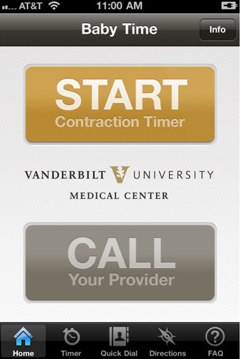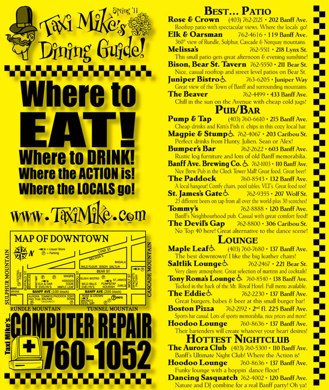Geek Squad understands YOUtility.

I was at a conference a couple years ago where
Robert Stephens, the founder of
Geek Squad, was speaking. He showcased their
YouTube channel which has hundreds of instructional videos on how to set your DVR, swap out a hard drive, and tasks of that nature.
Someone asked him a great question: “Let me get this straight Robert. You’re in the business of fixing things?” “yes” he nodded. “But yet, you have all these videos showing people how to fix things themselves. How does that make business sense?” “Well, our best customers are the people that think they can do it themselves. But even if they can, someday they’ll be over their head, and who will they call for help? We’re betting it’s the company whose logo they looked at for 8 minutes when we gave them free video help.”
Vanderbilt University Medical Center understands YOUtility.

They provide free of charge for expectant mothers a
Baby Time mobile app. It includes a contraction timer, a phone book to list contact information for people to call when the baby is on the way, a checklist of items to bring to the hospital, and driving directions.
Taxi Mike understands YOUtility.
Mike drives a cab for Banff Taxi in Alberta, and to stand out from the rest of the drivers, he produces an online and offline guide to the local hotspots.
Taxi Mike’s Dining Guide is a simple, 8.5×11, tri-fold rack brochure, printed on bright yellow paper, and available for free just about everywhere in town.

In his guide, Mike tells you the best BBQ places, clubs, happy hours, patios, places for kids, and other insider info. Wisely, he also includes a map of the downtown area on the front. The portable size and map make it perfectly logical to bring Mike’s Dining Guide with you when out on the town in Banff. And then, when you’re blurry-eyed at 12:30am, you pull out the guide and there is Mike’s phone number in big, bold letters.
Your Company Can Do This
In a world where every prospective customer is facing an invitation avalanche, where every business is asking people to follow their tweets, read their blog, or watch their videos, you must resist the temptation to communicate solely and endlessly about your company, hoping for a quick sale.
Helping can replace selling, or at the very least reduce the friction within that sales transaction. And you can do this. You can help your customers learn – like Geeksquad. You can help them plan – like Vanderbilt. You can help them enjoy – like Mike the Taxi Driver.
If you want to succeed in a world where the balance of marketing power has swung dramatically in favor of the customer, you need to become a YOUtility.
Plenty of examples how to involve customers in content creation
http://trendwatching.com/trends/CUSTOMER-MADE.htm

The easiest way for brands to dip their toes into CUSTOMER-MADE and tap THE GLOBAL BRAIN is to announce product or service development contests, open to consumers from around the world.
Let’s start with some CUSTOMER-MADE contests held since our
last update: they go beyond the usual ‘send-us-your-product-idea-and-win-a-voucher-for-a-free-ice-cream-
and-don’t-expect-us-to-actually-do-something-with-it’:



The Nokia
Concept Lounge took place in summer 2005 (some brands DO get it, and surprisingly it's often the brands that already have a strong competence in design or product development: ;-), but we thought the initiative was too well executed to not mention in this update. The lounge invited designers in the Benelux to share ideas and design the next new cool phone. Not surprisingly, in a GLOBAL BRAIN world, entries came from all over, with the winner being a Turkish designer,
Tamer Nakisci. His wrist-band style phone (the 'Nokia 888') must have had phone manufacturers from China to Finland drooling.

All of the examples above are a great way to really get started with CUSTOMER-MADE. But only a few companies have truly integrated this way of thinking into everything they do. One of the leaders in integrating CUSTOMER-MADE into its corporate fabric, P&G, is not slowing down: its
Connect + Develop program and other innovation projects now produce more than 35% of the company’s innovations. In fact, R&D productivity at Procter & Gamble has increased by nearly 60%. In the past two years, P&G launched more than 100 new products for which some aspect of development came from outside the company. Among P&G’s most successful connect-and-develop products to hit the market are Olay Regenerist, Swiffer Dusters, the Crest SpinBrush, and the Mr. Clean Magic Eraser (source: HBR, March 2006).

P&G also recently rebranded its Tremor Moms program to
Vocalpoint. In their own words: ‘’Vocalpoint is a unique marketing brand powered by the Procter & Gamble Company that helps companies do a better job developing products and services that moms care about and want to talk about. We work with this influential group of moms to help companies in industries that include entertainment, fashion, music, food and beauty. We collect feedback and generate valuable knowledge and insight for our clients through surveys, product sampling and previews of products and services.” P&G as the champion of CUSTOMER-MADE, to the point of selling its co-creation expertise to others. Not bad.

Moving past contests and gifts, this is where it gets really interesting: co-creators receiving a cut of whatever gets developed based on their input, suggestions, design or ideas.
Check out:

“Jetzt ist Ihre Kreativität gefragt!“ Austrian manufacturer Frenkenburger recently asked customers to come up with new flavours for its all natural hemp milk drink,
Trinkhanf. Plain hemp milk is highly nutritious but tastes bland, so Frenkenburger previously launched mango/ginger, cocoa/vanilla/maple and coffee-flavoured varieties. To further expand the Trinkhanf line, Frenkenburger challenged creative customers to create tasty new flavours using fruits, herbs, or other natural ingredients. A panel of judges is now in the process of picking a winner, and the winning recipe will go into production. Aware that co-creators should share in profits, Frenkenburger will pay the winner one euro-cent per bottle sold. Granted, that's not exactly spectacular, but it beats a 25 dollar voucher ;-)

Let's not forget CUSTOMER-MADE as an ongoing conversation, in many ways the Holy Grail of marketing. Think companies not just staging contests or asking for themed, detailed suggestions, but really hopping on the
Cluetrain Manifesto. The following examples are a start...

In the UK, Orange has set up
Talking Point, where customers can tell Orange how they feel about all sorts of things - not just phones. Orange promises to listen, and to use the info to shape the way they think about and do things in the future. A number of questions (like “what in your life would you like to see technology improve?”) make it easier for visitors to share their thoughts. This isn't really a sparkling conversation, but it's better than nothing, in what is still very much a one-way arena.














Ei kommentteja:
Lähetä kommentti